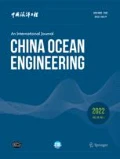Abstract
A control scheme named the variable-lateral-force cavitator, which is focused on the control of lift force, drag force and lateral forces for underwater supercavity vehicles was proposed, and the supercavitating flow around the cavitator was investigated numerically using the mixture multiphase flow model. It is verified that the forces of pitching, yawing, drag and lift, as well as the supercavity size of the underwater vehicle can be effectively regulated through the movements of the control element of the variable-lateral-force cavitator in the radial and circumferential directions. In addition, if the control element on either side protrudes to a height of 5% of the diameter of the front cavitator, an amount of forces of pitching and yawing equivalent to 30% of the drag force will be produced, and the supercavity section appears concave inwards simultaneously. It is also found that both the drag force and lift force of the variable-lateral-force cavitator decline as the angle of attack increases.
Similar content being viewed by others
References
Chen, W.Q., Wang, B.S., Yan, K. and Yi, S.Q., 2013. Study on the unsteady vertical cavity of the exit-water cavitor, Chinese Journal of Theoretical and Applied Mechanics, 45(1), 76–82. (in Chinese)
Chen, W.Q., Wang, B.S., Yi, S.Q., Zheng, J. and Chu, X.S., 2012. A theoretical investigation on the maximum pressure of the unsteady cavity closure position, Chinese Journal of Theoretical and Applied Mechanics, 44(4), 701–708. (in Chinese)
Chen, Y. and Lu, C.J., 2008. A homogeneous equilibrium model based numerical code for cavitation flows and evaluation by computation cases, Journal of Hydrodynamics, Ser. B, 20(2), 186–194.
Chen, Y.Y. and Luo, K., 2009. Attitude control of superspeed underwater vehicle in vertical plane, Computer Simulation, 26(1), 50–53. (in Chinese)
Fu, H.P., Lu, C.J. and Li, J., 2004. Numerical research on drag reduction characteristics of supercavitating body of revolution, Journal of Ship Mechanics, 124(3), 1–8. (in Chinese)
Gieseke, T.J., 2011. Telescoping Cavitator, U.S. Patent, US20090383081, June.
Harbin Engineering University, 2011. The Variable-Lateral-Force Cavitator, China Patent: No. 200910072007.3, April. (in Chinese)
Hu, X., Gao, Y. and Xiong, Y.L., 2011. Numerical investigation on supercavity shape control for underwater vehicles, Journal of Harbin Engineering University, 32(12), 1556–1562. (in Chinese)
Kuklinski, R., Castano, J. and Henoch, C., 2001. Experimental study of ventilated cavities on dynamic test model. Proceedings of the 4th International Symposium on Cavitation (CAV 2001), California, USA.
Luo, K., Dang, J.J., Wang, Y.C. and Zhang, Y.W., 2007. Motion characteristics on vertical plane of super-speed underwater vehicle, Torpedo Technology, 15(5), 37–40. (in Chinese)
Quan, X.B., Li, Y., Wei, H.P., Wang, B.S. and Kong, D.C., 2008a. An experimental study on cavitation of underwater vehicles surface at large angles of attack, Chinese Journal of Hydrodynamics, 23(6), 662–667. (in Chinese)
Quan, X.B., Wei, H.P., Kong, D.C. and Li, Y., 2008b. Numerical simulation on cavitation of submarine launched missile’s surface at large angles of attack, Journal of Astronautics, 29(6), 1701–1705. (in Chinese)
Savchenko, Y.N., 1997. Investigation of high speed supercavitating underwater motion of bodies, Proceedings of NATO-AGARD, Ukraine.
Savchenko, Y.N., 2001. Control of supercavitation flow and stability of supercavitating motion of bodies, Proceedings of the RTO/AVT Lectures Series on “Supercavitating Flows”, Belgium.
Savchenko, Y.N., Vlasenko, Y.D. and Semenenko, V.N., 1998. Experimental study of high-speed cavitation flows, Journal of Fluid Mechanics Research, 26(3), 103–111. (in Russian)
Semenenko, V.N., 2001. Artificial supercavitation physics and calculation, Proceedings of the RTO/AVT Lecture Series on “Supercavitating Flows” (CAV 2001), Belgium.
Singhal, A.K., Athavale, M.M., Li, H.Y. and Jiang, Y., 2002. Mathematical basis and validation of the full cavitation model, Journal of Fluids Engineering, 124(3), 617–624.
Xiang, M., Wu, X., Zhang, W.H. and Wang, Z.W., 2011. Three dimensional flow field simulation and performance analysis for a supercavitating vehicle, Engineering Mechanics, 28(2), 217–222. (in Chinese)
Yi, W.J., Li, Y.J., Wang, Z.Y., Xiong, T.H. and Qian, J.S., 2008. Characteristics of cavity shape for underwater high-speed projectile at small attack angle, Journal of Nanjing University of Science and Technology (Natural Science), 32(4), 464–467. (in Chinese)
Acknowledgements
The author would express the appreciation sincerely to his supervisor professor GAO Ye for his enthusiastic help in academic guide and modification of manuscript.
Author information
Authors and Affiliations
Corresponding author
Additional information
Foundation item: This work was financially supported by the National Natural Science Foundation of China (Grant Nos. 51379108 and 51609125), the Open Foundation of Engineering Research Center of Eco-environment in Three Gorges Reservoir Region, Ministry of Education (Grant No. 2015KF-03), and the University Scientific Research and Application Project of Yichang (Grant No. A16-302-a13).
Rights and permissions
About this article
Cite this article
Hu, X., Gao, Y. & Shi, Xt. Numerical study on characteristics of supercavitating flow around the variable-lateral-force cavitator. China Ocean Eng 31, 123–129 (2017). https://doi.org/10.1007/s13344-017-0015-4
Received:
Revised:
Accepted:
Published:
Issue Date:
DOI: https://doi.org/10.1007/s13344-017-0015-4



